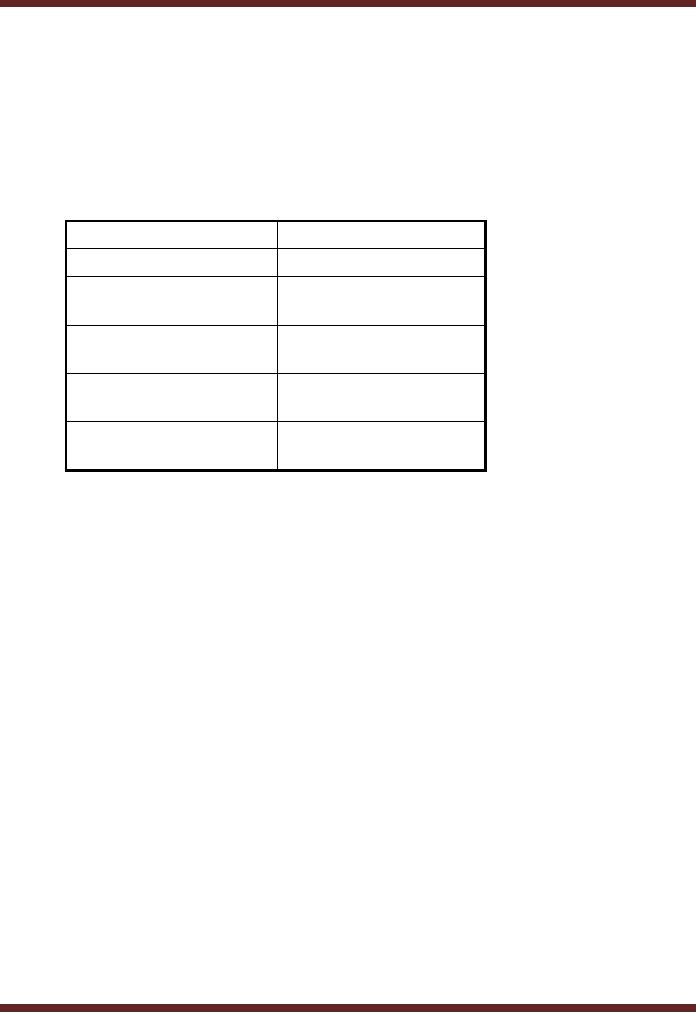 |

VU
Information
System (CS507)
LESSON
15
Decision
Making
There
are some of the critical decisions
that top managers face
every day. How to decide
whether to sell or
spin
off a business? Should the supplier relationships be
renegotiated? What can be done to
improve
decision-making
competency throughout your
organization?
To
capture maximum value,
executives not only must
make the right decisions,
but also must
negotiate
skillfully.
Since most business
decisions involve other
parties, it is essential for
managers to understand
their
individual
role as it relates to other
decision makers, as well as
how to use this knowledge to create
the
strongest
possible negotiating position.
Hence,
keeping in mind the importance of decision making
for managers, information
systems are also
designed
in a way to help them out to
control operations and perform
their managerial responsibilities
more
effectively.
Decision making is
the cognitive process of selecting a
course of action from among
multiple alternatives.
Cognitive
process is the mental process of
knowing, including aspects
such as awareness, perception,
reasoning,
and judgment.
�
Every decision-making process
produces a final choice. It
can be an action or an opinion.
� It
begins when we need to do
something but we do not know
what.
� A
decision-making is a reasoning process
which can be rational or irrational,
and can be based on
explicit
assumptions
or tacit assumptions.
15.1
Types of Problems
Nature
of problem determines the approach to
decision making to be followed to solve
it. There are three
broad
categories.
� Structured: Well-structured
problems are constrained
problems with convergent solutions that
engage the
application
of a limited number of rules and
principles within well-defined
parameters.
� Unstructured:
Problems possess multiple solutions,
solution paths, fewer
parameters which are
less
manipulate
able, and contain uncertainty about which
concepts, rules, and principles
are necessary for
the
solution
or how they are organized
and which solution is
best.
�
Semi-structured a
gray area lies between the
structured and unstructured range.
Here part of the
decision
can be specified allowing
for certain factors out of
control.
Types of
problems
A newly
formed organization may be taken as an
unstructured organization due to lack of
defined
organizational
structure, operating procedures. The
question that a problem is structured or
unstructured
is not
dependant on the organization being structured or
unstructured. Even a highly
structured
organization
can face novel and
unprecedented problems.
Example-Daily
Life
59

VU
Information
System (CS507)
� Unstructured
Mr. A thinks that he has to
wake up at any time in the
morning,
� Structured
Mr. A is a soldier and he has to
wake at 6 in the morning when army
bugle is played/blown.
This
procedure will be followed no
matter what.
� Semi
Structured Waking up is
subject to a clock alarm (procedure),
but it can be turned off as
waking
up at
that time is also subject to
some sort of individual judgment.
Example
Business
Bank
has a policy that two
persons, Mr. A & B would open the
bank 30 min before bank timings, so
that
bank should be open
for public dealing at 9 a.m.
No other situation has been
forecast in the policy.
� Structured
Staff
shall be in the bank by 8:00 a.m. to
ensure opening for public
dealing at 9 a.m.
This
procedure
will be followed no matter
what.
� Semi
Structured Branch
Manager is informed a day
earlier that Mr. A will be
unable to make it the
next
day.
Rest is left at the discretion of branch
manager's judgment to decide who
else is to be made
responsible
to open the branch in the morning.
� Unstructured
Employees start reaching before 9
a.m. but branch is not open.
The decision taken by
employees
there and then would be
totally unstructured due to the novelty
of the situation arose.
15.2
Type of Decisions
All
problems require decision making, however
the nature of problem determines
how it should be
approached.
The decision making process There
are three types of
decisions
�
Structured
�
Non-structured
� Semi
Structured
Structured
decisions
Where
problem is recurring and repetitive, the
common factors can be identified in
order to identify a
particular
course of action. Due to which
defined set of procedure can
be devised for their
solution.
Hence,
Procedures
for obtaining the best
solution are
standardized
o
Objectives
are clearly defined
o
Clearly
specified inputs and
outputs
o
Un-structured
decisions
When
problems are non routine,
critical and novel in nature, they
require individual judgment, evaluation
and
insight varying on case-to-case basis. There is no
well understood or agreed upon
procedure for
handling
these problems. For such
situations, predefined policy cannot be
devised. However, once
the
problem
has been figured out, a
policy may be devised to
handle the problem in future. This
can make
the
problem look like as
structured one giving regard
to the role of individual
judgment.
Semi-structured
Decisions
60

VU
Information
System (CS507)
The
term is used to refer to the grey area of
decisions which lie between
the two extremes. Some
(but
not
all) structured phases and
often solved using
standardized solution procedures
and human judgment.
In
small organizations decisions
are usually transferred from
form top to bottom. In large
organizations the
decision
are usually taken based on
meeting of all departmental
heads. The fact is that whether
decisions are
taken
by single person or all in a
formal meeting is not the
sole determinant of a decision being
structured
or unstructured.
Rather it simply shows the complexity of
the problem.
15.3
Decision-making process
�
Intelligence
searching for conditions in the
environment that call for
decisions
�
Design
inventing, developing, and
analyzing possible courses of
action
�
Choice
selecting a course of action from
those available
�
Implementation
implementing the selected course of
action
�
Monitoring
checking the consequences of the
decision made after
implementation
Phases
for Decision Making
Example
Any
deviation from the norm should be
reported as an exception for managers'
attention. As it is the
case
with "Debtors Aging Analysis". (Debtors
Aging analysis is the stratification of
trade receivables in
accordance
of period of time since they have
been due.)
Intelligence:
Identifying
the problems occurring in an organization. MIS is the
primary source for the
managers
to be aware of red-alerts.
Design:
Once
the debtors have been
analyzed on the basis of pattern of collection,
options can be
generated
to improve collection rates.
For example
Offering
early payment
discounts.
o
Devising
various collection strategies
for
o
various
classes of customer based
on
o
Collection
period
o
Discounts
rates
o
Strengthening
sales department for collecting revenue
through negotiation and
settlement.
o
Choice:
Now a
selection has to be made
which single strategy or
combination of strategies should
be
implemented.
Here a
DSS system can be used to
simulate the consequences of each
alternative generated.
o
The
diversity and complexity of the
alternatives generated would
determine how extensive the
DSS
o
system
should be.
Implementation: Now
the stage comes of communicating the
policy approved to the interested
and
relevant:
for example
Conducting
training sessions of sales department or
issuing an office
memorandum.
o
Communicating
and convincing customers of the
new credit terms so as to avoid
confusion.
o
Once
again MIS will be used to
record and report the results/effects of
the policy.
o
61

VU
Information
System (CS507)
Monitoring:
Once
the decision has been implemented, the
effects and responses should be
monitored. The
quality
of decisions can be judged only
once after they have been implemented.
Monitoring helps in
evaluating the
quality of decisions that
have been made. This
may include the following:
Quantifying
the speed in the process of
recovery.
o
Discount
costs being born by the
organization.
o
Customer
response in accepting the entire
policy.
o
Once
again MIS will be used to
record and report the
results / effects of the
policy.
o
Phases
Example
Intelligence
Debtor's
aging report
Design
Devise a
discount or
training
policy
Choice
Select a
discount/training
policy
Implementation
Implement
the
discount/training
policy
Monitoring
Evaluate
recovery patterns,
relevant
costs involved.
62
Table of Contents:
- Need for information, Sources of Information: Primary, Secondary, Tertiary Sources
- Data vs. Information, Information Quality Checklist
- Size of the Organization and Information Requirements
- Hierarchical organization, Organizational Structure, Culture of the Organization
- Elements of Environment: Legal, Economic, Social, Technological, Corporate social responsibility, Ethics
- Manual Vs Computerised Information Systems, Emerging Digital Firms
- Open-Loop System, Closed Loop System, Open Systems, Closed Systems, Level of Planning
- Components of a system, Types of Systems, Attributes of an IS/CBIS
- Infrastructure: Transaction Processing System, Management Information System
- Support Systems: Office Automation Systems, Decision Support Systems, Types of DSS
- Data Mart: Online Analytical Processing (OLAP), Types of Models Used in DSS
- Organizational Information Systems, Marketing Information Systems, Key CRM Tasks
- Manufacturing Information System, Inventory Sub System, Production Sub System, Quality Sub system
- Accounting & Financial Information Systems, Human Resource Information Systems
- Decision Making: Types of Problems, Type of Decisions
- Phases of decision-making: Intelligence Phase, Design Phase, Choice Phase, Implementation Phase
- Planning for System Development: Models Used for and Types of System Development Life-Cycle
- Project lifecycle vs. SDLC, Costs of Proposed System, Classic lifecycle Model
- Entity Relationship Diagram (ERD), Design of the information flow, data base, User Interface
- Incremental Model: Evaluation, Incremental vs. Iterative
- Spiral Model: Determine Objectives, Alternatives and Constraints, Prototyping
- System Analysis: Systems Analyst, System Design, Designing user interface
- System Analysis & Design Methods, Structured Analysis and Design, Flow Chart
- Symbols used for flow charts: Good Practices, Data Flow Diagram
- Rules for DFD’s: Entity Relationship Diagram
- Symbols: Object-Orientation, Object Oriented Analysis
- Object Oriented Analysis and Design: Object, Classes, Inheritance, Encapsulation, Polymorphism
- Critical Success Factors (CSF): CSF vs. Key Performance Indicator, Centralized vs. Distributed Processing
- Security of Information System: Security Issues, Objective, Scope, Policy, Program
- Threat Identification: Types of Threats, Control Analysis, Impact analysis, Occurrence of threat
- Control Adjustment: cost effective Security, Roles & Responsibility, Report Preparation
- Physical vs. Logical access, Viruses, Sources of Transmissions, Technical controls
- Antivirus software: Scanners, Active monitors, Behavior blockers, Logical intrusion, Best Password practices, Firewall
- Types of Controls: Access Controls, Cryptography, Biometrics
- Audit trails and logs: Audit trails and types of errors, IS audit, Parameters of IS audit
- Risk Management: Phases, focal Point, System Characterization, Vulnerability Assessment
- Control Analysis: Likelihood Determination, Impact Analysis, Risk Determination, Results Documentation
- Risk Management: Business Continuity Planning, Components, Phases of BCP, Business Impact Analysis (BIA)
- Web Security: Passive attacks, Active Attacks, Methods to avoid internet attacks
- Internet Security Controls, Firewall Security SystemsIntrusion Detection Systems, Components of IDS, Digital Certificates
- Commerce vs. E-Business, Business to Consumer (B2C), Electronic Data Interchange (EDI), E-Government
- Supply Chain Management: Integrating systems, Methods, Using SCM Software
- Using ERP Software, Evolution of ERP, Business Objectives and IT
- ERP & E-commerce, ERP & CRM, ERP– Ownership and sponsor ship
- Ethics in IS: Threats to Privacy, Electronic Surveillance, Data Profiling, TRIPS, Workplace Monitoring